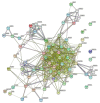Hereditary Spastic Paraplegia: From Genes, Cells and Networks to Novel Pathways for Drug Discovery
- PMID: 33810178
- PMCID: PMC8004882
- DOI: 10.3390/brainsci11030403
Hereditary Spastic Paraplegia: From Genes, Cells and Networks to Novel Pathways for Drug Discovery
Abstract
Hereditary spastic paraplegia (HSP) is a diverse group of Mendelian genetic disorders affecting the upper motor neurons, specifically degeneration of their distal axons in the corticospinal tract. Currently, there are 80 genes or genomic loci (genomic regions for which the causative gene has not been identified) associated with HSP diagnosis. HSP is therefore genetically very heterogeneous. Finding treatments for the HSPs is a daunting task: a rare disease made rarer by so many causative genes and many potential mutations in those genes in individual patients. Personalized medicine through genetic correction may be possible, but impractical as a generalized treatment strategy. The ideal treatments would be small molecules that are effective for people with different causative mutations. This requires identification of disease-associated cell dysfunctions shared across genotypes despite the large number of HSP genes that suggest a wide diversity of molecular and cellular mechanisms. This review highlights the shared dysfunctional phenotypes in patient-derived cells from patients with different causative mutations and uses bioinformatic analyses of the HSP genes to identify novel cell functions as potential targets for future drug treatments for multiple genotypes.
Keywords: endoplasmic reticulum; motor neuron disease; neurodegeneration; protein-protein interaction network; spastic paraplegia.
Conflict of interest statement
The authors declare no conflict of interest.
Figures







References
-
- Elsayed L.E.O., Eltazi I.Z.M., Ahmed A.E.M., Stevanin G. Hereditary spastic paraplegias: Time for an objective case definition and a new nosology for neurogenetic disorders to facilitate biomarker/therapeutic studies. Expert Rev. Neurother. 2019;19:409–415. doi: 10.1080/14737175.2019.1608824. - DOI - PubMed
Publication types
LinkOut - more resources
Full Text Sources
Other Literature Sources

